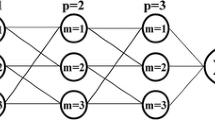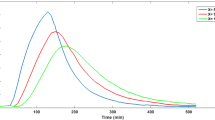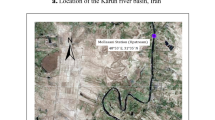Abstract
Accurate prediction of longitudinal dispersion coefficient (K) is a key element in studying of pollutant transport in rivers when the full cross sectional mixing has occurred. In this regard, several research studies have been carried out and different equations have been proposed. The predicted values of K obtained by different equations showed a great amount of uncertainty due to the complexity of the phenomenon. Therefore, there is still a need to make an improvement on the existing predictive models. In this study, a multi-objective particle swarm optimization (PSO) technique was used to derive new equations for predicting longitudinal dispersion coefficient in natural rivers. To do this, extensive field data, including hydraulic and geometrical characteristics of different rivers were applied. The results of this study were compared with those of the previous studies using the statistical error measures. The comparison revealed that the proposed model is superior to the previous ones. According to this study, PSO algorithm can be applied to improve the performance of the predictive equations by finding optimum values of the coefficients. The proposed model can be successfully applied to estimate the longitudinal dispersion coefficient for a wide range of rivers’ characteristics.




Similar content being viewed by others
References
Altunkaynak A (2016) Prediction of longitudinal dispersion coefficient in natural streams by prediction map. J Hydro Environ Res 12:105–116
Azamathulla HM, Ghani AA (2011) Genetic programming for predicting longitudinal dispersion coefficients in streams. Water Resour Manag 25:1537–1544
Azamathulla HM, Wu F-C (2011) Support vector machine approach for longitudinal dispersion coefficients in natural streams. Appl Soft Comput 11:2902–2905
Chau K (2004) River stage forecasting with particle swarm optimization. In: International Conference on Industrial, Engineering and Other Applications of Applied Intelligent Systems. Springer Berlin Heidelberg, pp 1166–1173
Chow VT (1959) Open-channel hydraulics. McGraw-Hill, New York
Deng Z-Q, Singh VP, Bengtsson L (2001) Longitudinal dispersion coefficient in straight rivers. J Hydraul Eng 127:919–927
Deng Z-Q, Bengtsson L, Singh V, Adrian D (2002) Longitudinal dispersion coefficient in single-channel streams. J Hydraul Eng 128:901–916
Disley T, Gharabaghi B, Mahboubi A, McBean E (2015) Predictive equation for longitudinal dispersion coefficient. Hydrol Process 29:161–172
Eberhart RC, Kennedy J 1995 A new optimizer using particle swarm theory. In: Proceedings of the sixth international symposium on micro machine and human science. IEEE, New York, pp 39–43
Elder J (1959) The dispersion of marked fluid in turbulent shear flow. J Fluid Mech 5:544–560
Etemad-Shahidi A, Taghipour M (2012) Predicting Longitudinal Dispersion Coefficient in Natural Streams Using M5′ Model Tree. J Hydraul Eng 138(6):542–554
Fischer HB (1967) The mechanics of dispersion in natural streams. J Hydraul Div 93:187–216
Fischer HB (1975) Discussion of “simple method for predicting dispersion in streams”. J Environ Eng Div 101:453–455
Fisher HB (1968) Dispersion predictions in natural streams. J Sanit Eng Div 94:927–944
Godfrey RG, Fredrick BJ (1970) ‘‘Stream dispersion at selected sites.’’ US Geological Survey Professional Paper, 433-K, Washington, DC
Graf JB (1995) MEASURED AND PREDICTED VELOCITY AND LONGITUDINAL DISPERSION AT STEAI) Y AND UNSTEADY FLOW, COLORADO RIVER, GLEN CANYON DAM TO LAKE MEAD1. Wiley Online Library
Guymer I (1998) Longitudinal dispersion in sinuous channel with changes in shape. J Hydraul Eng 124:33–40
Hu X (2006) PSO tutorial URL: http://www.swarmintelligence.org/tutorials.php
Iwasa Y, Aya S 1991 Predicting longitudinal dispersion coefficient in open-channel flows. In: Proceedings of international symposium on environmental hydraulics. Hong Kong University Press, Hong Kong, pp 505–510
Jeon TM, Baek KO, Seo IW (2007) Development of an empirical equation for the transverse dispersion coefficient in natural streams. Environ Fluid Mech 7:317–329
Kashefipour SM, Falconer RA (2002) Longitudinal dispersion coefficients in natural channels. Water Res 36:1596–1608
Katsifarakis K (2012) Hydrology, hydraulics and water resources management: a heuristic optimization approach (vol.56). WIT press, Southampton
Koussis AD, Rodríguez-Mirasol J (1998) Hydraulic estimation of dispersion coefficient for streams. J Hydraul Eng 124:317–320
Li X, Liu H, Yin M (2013) Differential evolution for prediction of longitudinal dispersion coefficients in natural streams. Water Resour Manag 27:5245–5260
Liu H (1977) Predicting dispersion coefficient of streams. J Environ Eng Div 103:59–69
Liu B, Wang L, Jin Y-H, Tang F, Huang D-X (2005) Improved particle swarm optimization combined with chaos. Chaos, Solitons Fractals 25:1261–1271
McQuivey RS, Keefer TN (1974) Simple method for predicting dispersion in streams. J Environ Eng Div 100:997–1011
Noori R, Deng Z, Kiaghadi A, Kachoosangi FT (2015) How reliable are ANN, ANFIS, and SVM techniques for predicting longitudinal dispersion coefficient in natural rivers? J Hydraul Eng 142:04015039
Noory H, Liaghat AM, Parsinejad M, Haddad OB (2011) Optimizing irrigation water allocation and multicrop planning using discrete PSO algorithm. J Irrig Drain Eng 138:437–444
Nordin CF, Sabol GV (1974) Empirical data on longitudinal dispersion in rivers. US Geological Survey
Panda S, Padhy NP (2008) Comparison of particle swarm optimization and genetic algorithm for FACTS-based controller design. Appl Soft Comput 8:1418–1427
Piotrowski AP, Rowinski PM, Napiorkowski JJ (2012) Comparison of evolutionary computation techniques for noise injected neural network training to estimate longitudinal dispersion coefficients in rivers. Expert Syst Appl 39:1354–1361
Rutherford JC (1994) River mixing. John Wiley & Son Ltd. Chichester
Sahay RR (2011) Prediction of longitudinal dispersion coefficients in natural rivers using artificial neural network. Environ Fluid Mech 11:247–261
Sahay RR (2013) Predicting longitudinal dispersion coefficients in sinuous rivers by genetic algorithm. J Hydrosci Hydraul Eng 61:214–221
Sahay R, Dutta S (2009) Prediction of longitudinal dispersion coefficients in natural rivers using genetic algorithm. Hydrol Res 40(6):544–552
Sattar AM, Gharabaghi B (2015) Gene expression models for prediction of longitudinal dispersion coefficient in streams. J Hydrol 524:587–596
Sedghi M, Aliakbar-Golkar M, Haghifam M-R (2013) Distribution network expansion considering distributed generation and storage units using modified PSO algorithm. Int J Electr Power Energy Syst 52:221–230
Seo IW, Cheong TS (1998) Predicting longitudinal dispersion coefficient in natural streams. J Hydraul Eng 124:25–32
Taylor G 1953 Dispersion of soluble matter in solvent flowing slowly through a tube. In: Proceedings of the Royal Society of London A: Mathematical, Physical and Engineering Sciences, vol 1137. The Royal Society, pp 186–203
Taylor G 1954 The dispersion of matter in turbulent flow through a pipe. In: Proceedings of the Royal Society of London A: Mathematical, Physical and Engineering Sciences, vol 1155. The Royal Society, pp 446–468
Toprak ZF, Cigizoglu HK (2008) Predicting longitudinal dispersion coefficient in natural streams by artificial intelligence methods. Hydrol Process 22:4106–4129
Toprak ZF, Hamidi N, Kisi O, Gerger R (2014) Modeling dimensionless longitudinal dispersion coefficient in natural streams using artificial intelligence methods. KSCE J Civ Eng 18:718–730
Yotsukura N, Fischer HB, Sayre WW (1970) Measurement of mixing characteristics of the Missouri River between Sioux City, Iowa, and Plattsmouth, Nebraska. USGPO
Yuan X, Wang L, Yuan Y (2008) Application of enhanced PSO approach to optimal scheduling of hydro system. Energy Convers Manag 49:2966–2972
Zeng Y, Huai W (2014) Estimation of longitudinal dispersion coefficient in rivers. J Hydro Environ Res 8:2–8
Zhang X, Srinivasan R, Zhao K, Liew MV (2009) Evaluation of global optimization algorithms for parameter calibration of a computationally intensive hydrologic model. Hydrol Process 23:430–441
Author information
Authors and Affiliations
Corresponding author
Appendix
Appendix
Rights and permissions
About this article
Cite this article
Alizadeh, M.J., Ahmadyar, D. & Afghantoloee, A. Improvement on the Existing Equations for Predicting Longitudinal Dispersion Coefficient. Water Resour Manage 31, 1777–1794 (2017). https://doi.org/10.1007/s11269-017-1611-z
Received:
Accepted:
Published:
Issue Date:
DOI: https://doi.org/10.1007/s11269-017-1611-z




